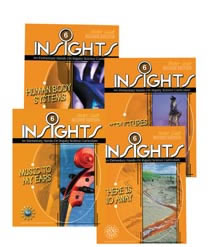Insights: An Inquiry-Based Elementary School Science Curriculum (Sixth Grade Modules)
By Karen Worth and the Insights Elementary Project Staff
 Insights is an innovative, inquiry-based, hands-on science curriculum for elementary school students. The full curriculum consists of 21 modules that represent a balance of life, earth, and physical science. The modules also highlight six major science themes: systems, change, structure and function, diversity, cause and effect, and energy. Each module is made up of a carefully sequenced, age-appropriate set of hands-on experiences designed to be directly relevant to the child. The modules are designed for use in self-contained elementary classrooms, and can be used as a core curriculum to be expanded as necessary, or individually in conjunction with existing programs.
Insights is an innovative, inquiry-based, hands-on science curriculum for elementary school students. The full curriculum consists of 21 modules that represent a balance of life, earth, and physical science. The modules also highlight six major science themes: systems, change, structure and function, diversity, cause and effect, and energy. Each module is made up of a carefully sequenced, age-appropriate set of hands-on experiences designed to be directly relevant to the child. The modules are designed for use in self-contained elementary classrooms, and can be used as a core curriculum to be expanded as necessary, or individually in conjunction with existing programs.
Contact Info: Karen Worth (1-800-225-4276 x2428)
Project Website: Insights: An Elementary Hands-on Inquiry Science Curriculum
Published by: Kendall/Hunt Publishing Order Info
Music to My Ears: This module takes advantage of adolescents' interest in music by using it as the springboard for investigating the generation, reception, and manipulation of sound. The learning experiences address common questions about sounds: What is sound? How do we hear sound? How do sounds shape our world? Through the use of string apparatus, homemade instruments, and models, students explore the physics of sound. Then they investigate the physiology of the ear and the unique structures of the ear. Students also look at the technology of recording, playing back, and amplifying sounds by examining records, CDs, and audiotapes and building their own speakers.
Price: Grade 6
(2nd Ed.)
Structures: In this module, students begin to develop an understanding of some of the basic principles that answer the question, "Why do structures stand up?" They look at structures in the school neighborhood, observing the variety in size, shape, material, and function. They build their own structures, using straws, index cards, and other materials. As they build, students explore some of the basic concepts of standing structures. These include live load, dead load, tension and compression, and the role of shapes and trusses. By comparing their structures with those in their community, students learn how structure and design are influenced by function, materials, and aesthetics. and aesthetics. At the end of the 13 lessons, students work together in groups to design a unique piece of playground equipment.
Price: Grade 6
(2nd Ed.)
There Is No Away: As our population increases, we generate more and more waste materials. In this module, students become aware of what happens to garbage when it is thrown away. They set up controlled experiments that yield information about what happens to organic and inorganic waste; and what it means for something to be "biodegradable;" and about the advantages and disadvantages of various disposal systems. Students also look at how waste affects water purity and explore ways of cleaning water by filtering, evaporation/distillation, and dilution. Throughout the module, the students are frequently asked "Where is away?" They grow more and more aware of the reality that there is no "away" and that conservation must be a major part of the solution to our trash problems.
Price: Grade 6
(2nd Ed.)
Human Body Systems: In this module, students look at how three different body systems work together to help their bodies function. They begin by looking at the needs their bodies have in order to perform a variety of physical tasks. As the module continues, the students engage in a variety of activities that demonstrate how the digestive, circulatory, and respiratory systems work interdependently to provide the cells in the body with the nutrients and energy they need.
Price: Grade 6
(2nd Ed.)
